Fiber Art: A Quilting Odyssey
Sunday, January 8, 2017
My current on and off again project, soon will be approaching it's 10 year in the making anniversary!!! I am soooo close to having this complete; the fabric is the original Ocean Songs by Laurel Burch, purchased in 2007. This project is the only item that survived my studio in 2008 when Hurricane Ike hit Galveston Island, and it survived by floating in a plastic tote inside my 1880s home in the historic East End of Galveston. I will post more photos of this project, which I have titled "Fractured Dreams", as this has been my go to project and has acted as a catharsis and a mechanism to cope with the loss from that event.
Friday, June 28, 2013
Wednesday, June 26, 2013
Saturday, June 22, 2013
Friday, June 7, 2013
Serger Seminar with Baby Lock National Educator Lori Hernandez
SERGER SEMINAR with Baby Lock Nation Educator Lori Hernandez!!! This is a 2 day event, sign up for either 1 or both days!! Come and join the fun at J&M Vac and Sew in Fort Collins:
Look At My Newest Handmade Fiber Art Yarn Scarves
These are the Fiber Art Yarn Scarves that I currently have for sale in my Etsy Boutique; I teach classes on the construction of these scarves utilizing your home sewing machine (no knitting or crocheting involved), USE this coupon code to receive 25% off: 25PERCENTOFFBLOG
Wednesday, June 5, 2013
Shetland Fleece Types
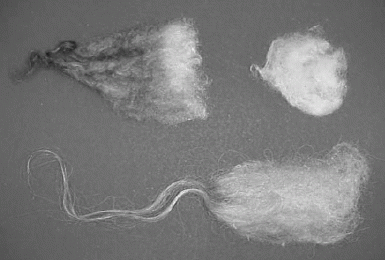
- Kindly/Single-Coated: Upper right in photo: Extremely soft and downy, usually very crimpy and dense. Roos nicely if caught in time. Short staple, typically 2 to 4 inches in length. Has a tendency to collect debris, but this can be easily removed through the use of the combing process during fiber preparation. Ideal for the softest, next-to-the-skin garments such as baby clothes.
- Longish and Wavy: Upper left in photo: Most typically seen. Fleece lengths are normally in the 4 to 6 inch range, with a slight “wispiness” on the ends of each lock. The fleece has a very open quality with the ends of each lock well-closed. Spins very easily. Nice for worsted wool applications, as in fine woven fabrics or knitwear with well-defined patterns that must be retained, as in Fair Isle sweaters.
- Beaver/Double-Coated: Bottom in photo: Long and luxurious. Fleece lengths are usually in the 6 to 10 inch and even longer range. The ideal double coat has well-defined separate coats that can be readily separated. The outer coat is hair like, while the undercoat is soft and downy. The two coats may be spun separately or together. The outer coats serves as a protective layer against harsher weather. This is the most versatile fleece.
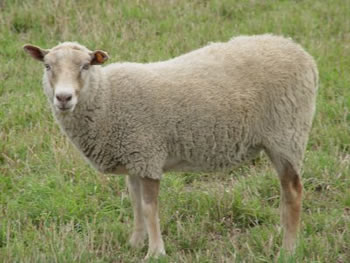
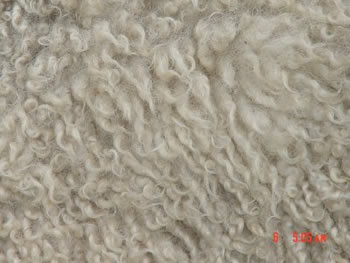
A single-coated ewe & fleece.
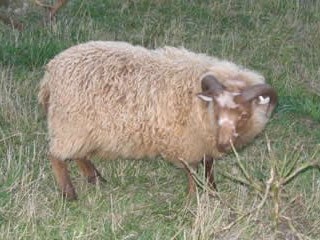
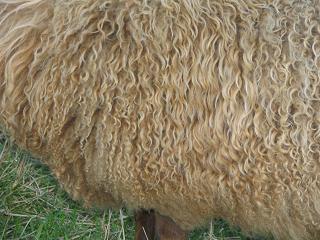
A long/wavy ram & fleece.
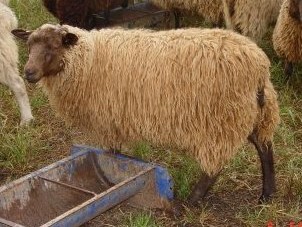
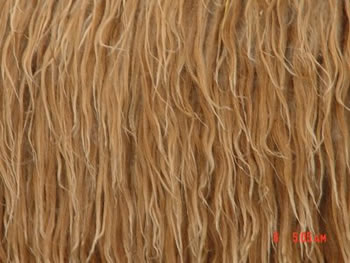
A double-coated ewe & fleece.
As an “unimproved” breed, the Shetland was not originally intended to
have a completely uniform fleece from head to tail. Traditionally, one
Shetland fleece was put to multiple uses by the crofters on the
Shetland Islands. It has been accepted that the neck wool is the finest
and crimpiest part of the fleece, and was used to make lace shawls and
hosiery. The shoulder wool is also more fine and crimpy, and was used
to make undergarments and baby clothes. The wool from the midsection
could be used for soft sweaters and outergarments. The britch wool was
used for socks. This variability in the Shetland fleece is traditional,
and should not be discriminated against in the show ring. Again, the
softness of the fleece is the most important trait.Efforts have been made on Shetland and mainland Scotland to make the Shetland a more commercially viable breed. The Modern type Shetland does have a more uniform fleece from head to tail, and is usually very soft and crimpy with a medium length single-coated fleece. This type of fleece is more easily handled by commercial processors.
Courtesy of NASSA: http://www.shetland-sheep.org
History of Shetland Sheep
The roots of the Shetland Sheep go back over a thousand years, probably to sheep brought to the Shetland Islands by Viking settlers. They belong to the Northern European short-tailed group which also contains the Finnsheep, Norwegian Spaelsau, Icelandics, Romanovs and others.Qualities of the Breed
Shetland Sheep are a small, calm breed of sheep — ideal for a small flock!Shetlands are one of the smallest of the British sheep. Rams usually weigh 90 to 125 pounds and ewes about 75 to 100 pounds. Rams usually have beautiful spiral horns, whereas the ewes are typically polled. They are fine-boned and agile and their naturally short, fluke-shaped tails do not require docking.
They are a calm, docile and easy-to-manage breed. Most respond well to attention and some even wag their tails when petted!
Although Shetlands are small and relatively slow growing, they maintain natural hardiness, thriftiness, easy lambing, adaptability and longevity. Shetlands survived for centuries under harsh conditions and on a meager diet, although they do very well under less rigorous conditions. Having retained many of their primitive survival instincts, they are easier to care for than many of today’s commercial breeds.
Use the links below for more information about Shetland Sheep.
- About Shetlands
- Breed Standard
- Shetland Wool
- Shetland Colors
- Shetland Markings
Courtesy of NASSA at http://www.shetland-sheep.org
Subscribe to:
Posts (Atom)













































